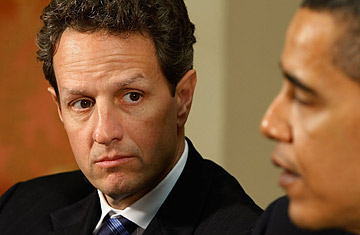
President Barack Obama, right, talks to the media after a meeting with officials from the credit-card industry and Treasury Secretary Timothy Geithner at the White House
One of the ways to see the "credit crunch" that helped kick off our broader economic trouble is by looking at how much companies have to pay to borrow money. For the better part of a year, the premium that firms have had to shell out above what investors could alternatively earn on government bonds has been fantastically high.
There are signs, though, that such credit spreads are moderating. Though far from anything that might be characterized as "normal," it is nonetheless a good sign for the Federal Government's credit-easing efforts that corporate borrowing costs have fallen to their lowest level since October, according to indexes that track the price of company bonds. (See the best business deals of 2008.)
Treasury Secretary Timothy Geithner got at this in congressional testimony on April 20. "Indicators on interbank lending, corporate issuance and credit spreads generally suggest improvements in confidence in the stability of the system and some thawing in credit markets," he said.
Interbank lending — another gauge of credit conditions — is often captured by the TED spread, which measures the premium banks pay over government bonds when they borrow money from one another. The difference is now just about 1 percentage point — what it was before Lehman Brothers filed for bankruptcy protection last September.
That's nothing like the quarter-to-half-point premium banks had gotten used to in the early 2000s, but it's still well down from 1.4 percentage points at the beginning of the year. Not to mention the 4.6-point gap it hit in the worst of the market freakout last fall.
Not all companies, though, are seeing the same benefit. As a recent Merrill Lynch report pointed out, when companies with lower credit ratings are going to issue debt, they're still paying up. Bonds that fall in the lowest category that still manage to be considered "investment grade" are yielding 5.3 percentage points more than government bonds. That's down from a high spread of 6.2 but still far above the 22-year average of 2.2 points. High-yield bonds, which are even riskier, are at a spread of 15.2. That's down from a high of 19.8 — yet three times the long-term average of 5.4.
What that means is that the firms going out to raise money tend to be the ones with better credit quality. In March, companies raised $116 billion by issuing bonds. That was the most since May 2007. However, of that $116 billion, a full $115 billion was raised by high-grade issuers.
Is that a reason to be optimistic? Sure. Is it time to break out the champagne? Hardly.
